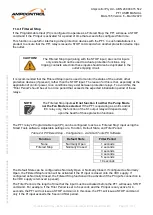
Ampcontrol Pty Ltd
– ABN 28 000 915 542
PF1 USER MANUAL
MAG-165 Version 6
– March/2020
Uncontrolled Copy - Refer to Ampcontrol Website for Latest Version
Page 42 of 71
A
P
P
R
OV
E
D
FOR
E
X
T
E
R
N
A
L
D
IS
TR
IB
U
T
ION
–
P
R
OP
E
R
T
Y
OF
A
M
P
C
ON
TR
OL
P
T
Y
LTD
–
N
O
T
T
O
B
E
R
E
P
R
OD
U
C
E
D
I
N
P
A
R
T
In latching mode, the PF1 must be reset after the fault has been cleared, before the outlet can be
started.
The EC shunt resistance monitoring function has a built in hysteresis function that prevents an earth
continuity trip from being reset if the measured resistance is hovering around the trip level. The
resistance must increase above the trip level plus the hysteresis amount before an earth continuity fault
can be reset. The earth continuity shunt hysteresis has a default setting of 100
Ω. This value is fixed in
this version of the PF1.
9.3 EC Latching Mode (Selectable)
When the PF1 is set to latching mode, all earth continuity faults need to be reset manually. A latched
earth continuity trip will prevent the outlet from starting, even if the earth continuity fault has been
rectified.
9.4 EC Reset Procedure
To use the reset function, the user must connect a switch (normally open momentary pushbutton)
between the Reset input terminal (5) and the VDC digital input supply terminal (4) (see Figure 4.4).
The user must manually reset an earth leakage trip after a fault has occurred. The procedure is as
follows:
1. Investigate and rectify the fault as per site procedures.
2. Press the reset button for a minimum of 300ms.
NOTE
Performing a reset operation will reset all of the PF1 relay’s latched
trips, provided any fault conditions are no longer present.
9.5 Remote Operation Functionality
Provided that the PF1 r
elay’s earth continuity protection function is enabled, the PF1 allows a remote
start and a remote stop pushbutton to be installed in the motor enclosure. This allows the outlet to be
energised and de-energised remotely at the motor, eliminating the need for the operator to return to the
power supply enclosure for general operations.
Figure 9.1: Remote Start & Remote Stop Implementation
Motor
Enclosure
M
100Ω
STOP
START
A
B
C
P
E
















































